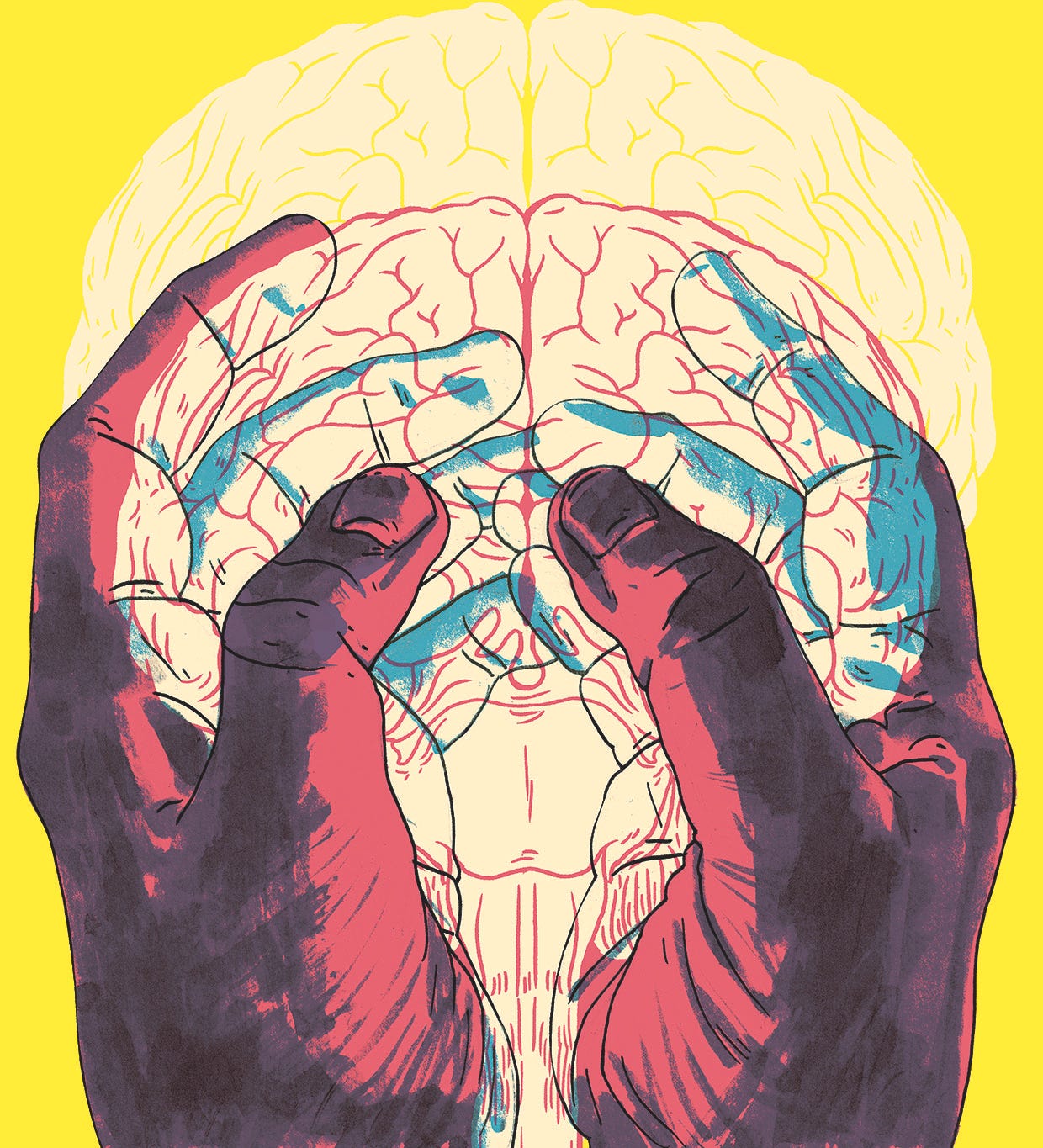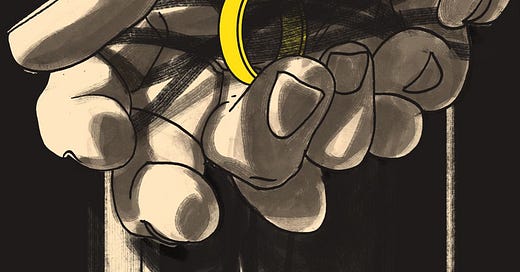
1.
Ever since I was a young boy, I have been fascinated by hands. To me, hands tell the story of people. They symbolise, in many ways, the struggle to be human and the context for that struggle. Take my father’s hands; rough, square palmed, calloused, short fingered hands built for hueing stone and for violence. Or my mother’s hands; more gentle, longer, covered in paint and earth, made for manipulating the world around her. I remember comparing my hands to my parent’s hands in the same way my daughter does now. The feeling was of establishing a deep connection with that person, my progenitor, and placing myself in the context of my family history. A history of stone masons, potters, painters, artisans of all kinds. It is a history of shaping the world by the dexterity of our fingers. It is also one of violence. The trauma and socioeconomic impact of post war Scotland was laid down physically into the hands of my father. One of my earliest memories is of my father showing me how to form a fist correctly so as not to break a knuckle on someone’s skull. His knuckles were perfectly square and flat from years of practice.
Thankfully, my hands never got as much violent practice as my father but they are similar in their form. My hands are square palmed with short strong fingers. They are also unusually large for my height. When I look at them, I see generations of people who made things. People who created and crafted a world to suit their needs. They created and used tools. They built homes, castles, cathedrals. They tended the land and decorated their homes with objects they had made. Pottery, furniture, instruments. They made art when they had the time for it.

2.
I think the evolution of our hands is inextricable from the evolution of human intelligence. As our brains became more capable at solving the problem of survival, so too our hands became more capable at manipulating the world around us. Each facilitated the other. It was, I believe, probably an iterative process. A feedback loop. The brain solves the problem while the hands enact and apply the solution. And as our hands became more and more dextrous, the solution became more and more refined. Our brains required this dexterity to enact the solution but they also learned from it. The limitations and ability of the hands, informed the route of the solution.
But hands go much deeper than intelligence. They speak to us on an emotional level. Touching another person creates a profound connection. A connection that is orders of magnitude greater than speaking. It ignites the whole mind, including the ancient bits, perhaps because it is such a primitive form of communication. But by the dexterity of our fingers, our hands render a juxtaposition between primitive communication and a nuanced delivery of meaning. Much like music. It is the articulation of complex abstraction translated at an emotional centre of the mind and body. In short, it hits harder.
The touch of hands is so profound, that even imagining it can recreate a powerful reaction. No wonder then that the hand has become deeply symbolic in probably all cultures around the world. A hand gesture can provoke a visceral reaction, be it positive or negative. Hand signs hold deep meaning to many religions and cultures. I think this is because our hands are a fundamental part of our humanity. Of course, the whole of our body and its processes is fundamental to the evolution of human emotion, culture, society and intelligence but the hand, for me, is one of the most diverse parts. I wouldn’t want to undermine the importance of other body parts that are essential to our providence, and which are a source of great fascination to many many people. But I feel those bits are less diverse in their function and less nuanced in their ability to manipulate and create human culture. Maybe?
3.
I like to draw hands. If I get a commission with the opportunity to draw hands, I will probably push that idea more than any other. The illustration above is for a piece by Cate Hall at Useful Fictions. The essay is about ‘Forcing functions’; to guarantee our motivation to complete a task, we must first tie ourselves to it. In the essay Cate refers Odysseus:
At certain points in the relationship, it would be fitting to imagine us like Odysseus, who tied himself to his ship’s mast so he could hear the song of the sirens — writhing against the ropes, tempted by the prospect of breaking free, but held in place by restraints wisely tied by a previous self.
I based the concept for the illustration on this point in the essay and pushed for this idea. Cate graciously let me go with the concept and I think it turned out quite well.
4.
I have always enjoyed drawing hands. While still in high school, I filled four or five sketchbooks with nothing but drawings of hands in preparation for my application to art college. I was going to fill some more sketchbooks with drawings of feet but I never got round to it.
For a young artist, the ability to draw a convincing hand is a milestone in artistic development. Drawing a hand requires an understanding of the anatomy of a hand but also a looseness of pencil stroke. Conforming to anatomy too rigidly can lead to stiff little fingers and dead hands. Hands are rarely rigid. They are opposable, the tip of each finger can touch the tip of the thumb, but despite this apparent diversity of form, each finger is remarkably constrained to just a few degrees of freedom. They can’t twist for example. But they can be contorted by external forces like another hand or a tool.
Musicians fingers contort into seemingly impossible configurations and when drawn according to anatomical rules alone, can easily look deformed or wrong. Drawing contorted fingers requires simultaneously abandoning your understanding of the anatomy of the hand while maintaining a sense of reality. It requires a close attention to the visual information in front of you and a delicate understanding of what your audience expects a hand to look like. There is meat and flesh that obscures the underlying structure. It’s a tight balance.
As I have grown in confidence drawing hands, I have become less bothered about accuracy. I don’t worry about whether it looks right or not. As long as the overall effect is convincing, it doesn’t matter if each finger is exactly right. In fact, look closely at many great examples of historic and modern figure paintings and you will find all sorts of funny looking hands. Lots of pig’s trotters and sausages. But on the whole, they are convincing. And sorry to mention AI, but it struggled with hands for quite a while. Have they solved the hand problem yet?
5.
The role of hands in my life is ripe with metaphor. You may have noticed a few of my comics use hands as a literary device, like in The Laccolith series, an autofiction based on my relationship with my father. The hands reflect my sense of self in opposition to my father’s opinion of me. Our hands are similar in form but used in very different ways. Deformed in different ways. More to come on that.
The hand is thronging with metaphor. Not just for me, but for the whole of human civilisation. Palm reading, life lines, death lines, the shaka, thumbs up, thumbs down, up yours, and so on. Love, death, birth, marriage, our hands are there, holding, caressing, protecting, grasping. We rely on them everyday for almost everything we do. To lose the use of our hands is profoundly life changing. Not just for our day to day survival, but for our core being and identity. They are an invaluable tool and part of who we are as a species. Our hands bind us together in a way that language alone cannot achieve. Reaching to take another’s hand forms a connection that technology will never replace.
But the real reason I like to draw hands is laziness. They are right there in front of me all the time. I don’t have to search for subject matter. I just lay a hand out and draw it. And it is less painful than a self portrait.
ps
Some tips if you want to draw hands.
Draw hands over and over and over again.
Never worry about what the drawing will look like. Hate the drawings. Make them intentionally ugly.
Take advice from Moebius: dismantle your ego, let go, then draw if you want to.
Chiaroscuro lighting helps.







